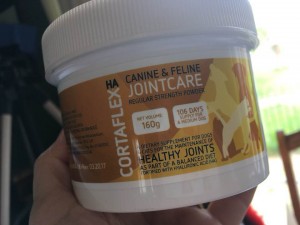Spondylosis or “Spondylosis Deformans” in dogs sounds like a very serious diagnosis and there is no doubt that it’s effect on a dog’s quality of life can be marked BUT what if I were to tell you that pretty much any dog that lives long enough, will eventually develop spondylosis to some degree? Didn’t know that? Read on 😉
Although it is usually something that, as I say, effects older dogs, it is thought that it can also be triggered by traumatic injuries, excessive wear and tear, poor dietary management/nutrition, or even a genetic predisposition. It is most frequently seen in larger breed dogs, but please don’t think that they have the monopoly on this disease – ANY breed can suffer with spondylosis.
So firstly, what is SPONDYLOSIS? Well, the spinal column is made up of 30 vertebrae (bones) and some tail bones too. Between each of these vertebrae is a spongy disc which acts as a shock absorber and allows the spinal column to flex and bend. As dogs get older, these vertebrae can develop bony spurs which, over time, can actually join together and form a kind of bridge along the bottom edge of the spinal column. As the vertebrae fuse together, bending and flexibility becomes less. It can also happen if the spinal column has been damaged and weakened through injury, in which case the body will form a bridge of bone along the gap of the injury to strengthen that area and shore it up.
As you’d imagine, this can be an extremely painful condition to experience although, that said, in many cases dogs live with it and show little or no signs of pain and still enjoy a good quality of life, perhaps with nothing more significant than a stiffness which reduces his flexibility. Clues that your dog may be experiencing this condition are many and really you, as his guardian, are probably the best person to spot the early onset of this condition. You may notice:
Change in their general mood, perhaps being more grumpy with people or other dogs.
A reluctance to trot up the stairs if they don’t have to or to jump in/out of the car.
A difficulty in bending down to get to their bowl due to stiffness in the neck.
An arched back/low head appearance.
Stiffness.
Lameness.
Sensitivity to touch of the effected area.
Difficulty getting up or lying down.
Reluctance to walk a full distance daily walk.
So, how will your vet diagnose Spondylosis? Well firstly she will want to examine your dog and see what range of movement he has and detect any sensitive parts. As you’d imagine if it were you, this can be very painful so your vet may ask to muzzle your dog to do this, even if he is the sweetest dog in all the world! (If you have not taught your dog Muzzle Acceptance, this can add to the stress burden so please do try to acclimatise your dog to the use of muzzle for just such an occasion – Teaching Muzzle Acceptance blog
After a general examination, she may opt to perform more technical investigations such as X-Rays, CT Sans, MRI or something called Myelography which is where a contrast dye is used so that it shows up on X-Ray or CT scan and highlights any defect or problem area.
Once your dog has been diagnosed, there is unfortunately no cure or way of reversing the condition, although in severe cases surgery to remove the spurs could be considered. Alternatively, you may be offered Non-Steroidal Anti-Inflammatory medication as pain management with drugs such as Metacam, Loxicam or Previcox.
At this stage, I would probably recommend switching to a harness to walk your dog, if you do not already do so. A collar can put added strain on the neck which should be avoided. Perhaps also consider switching to a raised bowl to feed your dog if you are not already doing so. That extra effort to bend down to get to their food could probably be alleviated by this very easy modification … and I’m sure they’d appreciate a pain-free dining experience!
To manage their comfort and aid with flexibility in the joints, there are some really good supplements you can also try (some work better for some dogs so do have a try with various ones to see which suits your dog best 😉 ) Glucosamine and Chondroitin are popular supplements to try, as is YuMove which has very good reviews. Another joint supplement you could try is Canine Cortaflex HA which I have used on my boys with very good results. You simply add a measured sprinkle to their breakfast and that’s you done. You may find that the best solution is to couple a pain medication with one of these joint supplements rather than relying solely on one or the other.
Many people who like to do things “naturally” also extol the virtues of turmeric paste as a natural anti-inflammatory (there are many groups of Facebook for example where you can speak to people who use this daily and are a wealth of knowledge on the subject). As with any natural or herbal approach, please do your research to ensure that this line of support is right for your dog, his history and any other medication he me also be on. Coconut oil is another natural approach which has proven to be very good with many aspects of health, including joint mobility, but please be aware that it is extremely calorific and if you are adding this into your dog’s diet, you need to cut back on his calories somewhere else to accommodate it’s introduction. If you don’t, your dog is likely to start piling on the pounds which, with this condition, he can ill afford.
Other things you can do to help the comfort and mobility of your dog include, firstly, ensuring that they continue with daily exercise and keep their weight under control. A dog who weighs more will be exerting more stresses on every joint in his body, including his vertebral column, so keeping him trim will definitely keep him more comfortable. Exercises such as swimming and walking are by far the better choices than high impact sessions such as running as they put less stress on the joints and in the case of swimming, the water actually supports the body while still allowing a vigorous workout. You may well find that therapeutic massage can really help as well. Massage is a complementary therapy which treats the whole body of the dog, reduces swelling, increases flexibility and also helps drain metabolic waste from muscles and tissues. Please ensure that your vet is happy with your chosen practitioner and that he or she has the necessary qualifications to carry out such treatments on your dog safely.
As with anything, as the condition deteriorates, they may need more and more support with pain relief to ensure a good quality of life. At this point, when everything else has been tried, your vet may suggest using steroids to help him cope. This is something that should be approached with caution and only after everything else has been exhausted as, sadly, there are side effects when used over the long term. I would certainly advocate discussing this with your vet and getting his professional opinion to balance your decision.


